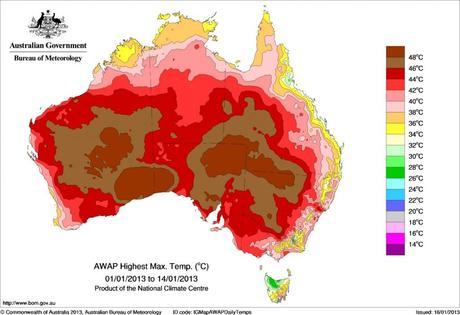
by Alex White / The Guardian
Australia’s temperatures have warmed by “about 1° C since 1910″according to the Bureau of Meteorology, and 2013 was the hottest yearsince records began in 1910.
In the last 11 months leading to November 2013 average temperatures “were 1.25°C above average” and 2013 saw maximum temperatures 1.45°C above the average.
The full update is available from the BOM here.
It bears repeating: 2013 was Australia’s hottest year on record and globally the seventh hottest year on record.
Most of Australia is sweltering under a heatwave, the likes of which it has not seen since… well, last year.
These facts come as the Australian government approves the expansion of a new coal export port on Abbot Point, and the creation of coal “mega-mines” in the Galilee Basin.
The “mega-mine” is a project headed by newly elected parliamentarian and coal-baron Clive Palmer, called the China First mine (Galilee Mine Project). It has come under fire recently for being economically unsustainable, largely due to the waning demand for coal and the growing carbon bubble.
The mine, if it were to proceed, would mine and export around 40 million tonnes of coal each year. This would equate to 95 million tonnes of CO2. Carbon dioxide released from the burning of fossil fuels like coal is a major contributor to Australia’s greenhouse gas emissions, and to global warming.
In 2009, the average individual carbon emissions for an Australian was around 18.38 metric tonnes per year, so the China First Mine would be equivalent to adding a population of around 5.1 million extra people each year.
To put this into a global scale, the Keystone XL pipeline, which is the target of massive community protest in the USA and Canada due to itstoxic mining of tar sands, would produce around 935 million to 1.2 billion tonnes of carbon pollution over its 50 year life-span. This equates to 24 million tonnes of carbon dioxide per year.
This single coal mine is around 3 times more polluting than the entire Keystone tar sands project.
There are ten other coal projects proposed for the Galilee Basin.
This amounts to a carbon bomb, that if allowed to explode, would blow Australia and the world past it’s carbon budget.
Most of Australia’s carbon emissions come from burning coal for electricity, and one third of global emissions is due to coal.
The Australian government’s stated position is to “five per cent reduction in emissions by 2020″. Their policy doesn’t state the benchmark from which reductions are measured, but their target was based on the commitment made by the previous Labor government which was pegged to 2000.
Prime minister Abbott’s policy of 5% reductions is deeply concerning, not only because the target is not credible, or that it is a sham of a policy designed to hide the climate-change denialists in the Liberal Party, but because his means of achieving it is to hand over $3 billion to big polluters.
About a year ago, Tony Abbott spoke at a campaign event in Lidcombe during the 2013 heatwave. He said:
Isn’t it bizarre that this government thinks that somehow raising the price of electricity is going to clean up our environment, stop bushfires, stop floods, stop droughts? Just think of how much hotter it might have been the other day but for the carbon tax!
Labor’s carbon price aimed for a 5% reduction in carbon emissions.
Abbott’s joke at the ineffectualness of the carbon price to affect the climate raises the question: does he believe that his “direct action” sham will reduce the greenhouse effect or cool the weather?
Even if the appalling “direct action” plan somehow actually succeeded in reducing Australia’s carbon emissions by 5% (which an increasing number of scientists doubt), the purpose of reducing carbon emissions at all is to try to halt global warming at a maximum of 2°C warming.
Prime minister Abbott said at a press conference after snubbing global climate talks in Warsaw in November that:
our position is back here in Australia and that is that we accept that climate change happens, that mankind, humanity, make a contribution to it and it’s important that we take strong and effective action against it. We will meet our five per cent emissions reduction target but this government has made no commitments to go further than that and we certainly want to get emissions down as far as we reasonably can but we are certainly in no way looking to make further binding commitments in the absence of very serious like-binding commitments in other countries and there’s no evidence of that.
What precisely “strong” and “effective” action against climate change means for the Australian government and Tony Abbott is alarmingly vague. Certainly, the “direct action” policy fails to meet the criteria of effective.
The policy objective of digging up the Galilee Basin’s coal reserves and setting off a carbon bomb likewise fails.
With last year blitzing heatwave records, and the start of 2014 looking to follow, Australia cannot afford to swelter under a joke climate policy.

